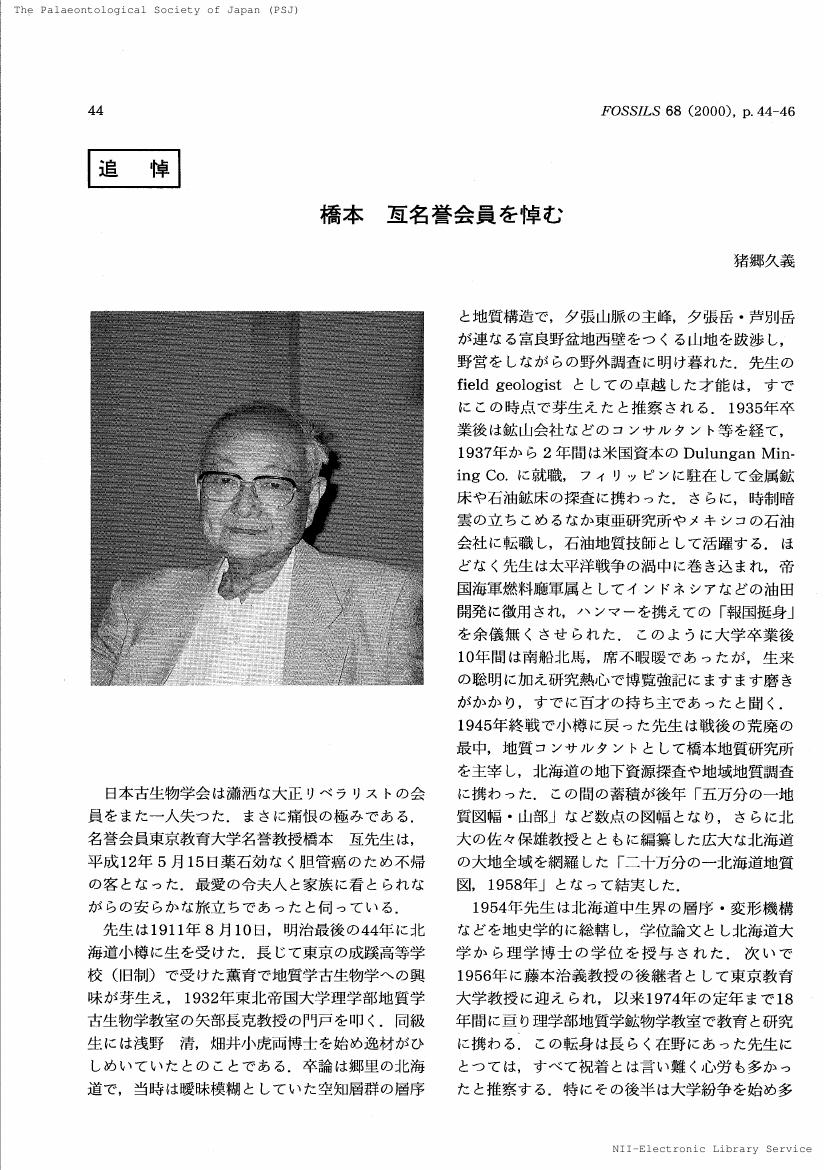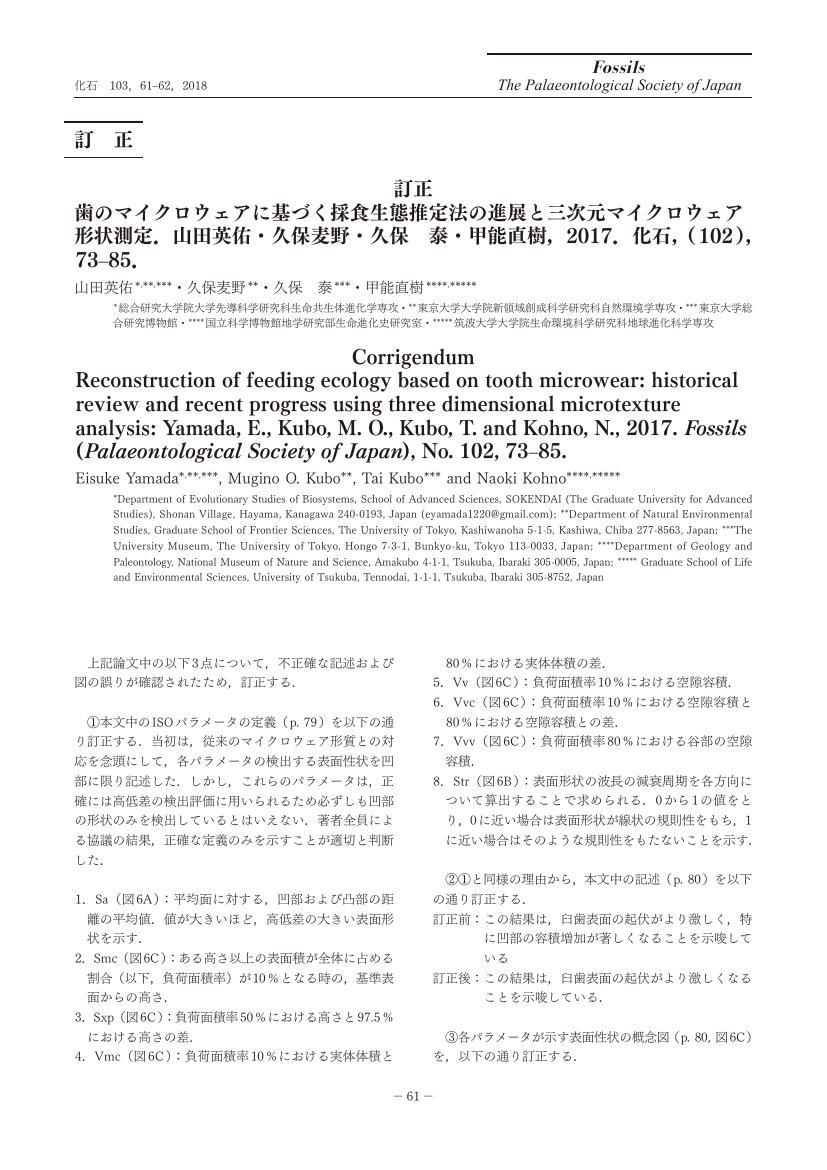1 0 0 0 OA 首長竜(ふぉっしる)
- 著者
- 佐藤 たまき
- 出版者
- 日本古生物学会
- 雑誌
- 化石 (ISSN:00229202)
- 巻号頁・発行日
- vol.85, pp.69-71, 2009-03-31 (Released:2017-10-03)
- 参考文献数
- 16
1 0 0 0 OA 始新世/漸新世境界付近における南大洋の古海洋学
- 著者
- 舟川 哲
- 出版者
- 日本古生物学会
- 雑誌
- 化石 (ISSN:00229202)
- 巻号頁・発行日
- vol.73, pp.20-37, 2003-03-20 (Released:2017-10-03)
- 参考文献数
- 83
本論では, 南大洋における後期始新世から漸新世にかけてのテクトニクスイベントおよび堆積物から読みとれる気候イベントを総括し, 海洋の微化石群集の変化が, これらとどのように結びついているかを論じた(図14).(1)後期始新世では, 南タスマン海膨が沈降を開始し, インド洋-太平洋間に海路が徐々に形成され始めた.すでにこの時期に海水温の低下がみられるが, その原因はよくわからない.酸素同位体比および南極大陸縁辺の堆積物からみると, このとき南極大陸には短期間ではあるが, 小規模な氷床が形成されていた.この寒冷化によって, 海洋の石灰質微化石(浮遊性有孔虫, 石灰質ナノ化石)は, 温暖種が段階的に絶滅した.珪質微化石は, 温暖種が徐々に絶滅する一方で, 新たに出現する種がみられるようになり, 群集全体の種数も増加した.(2)E/O境界付近では, インド洋-太平洋間に表層水が通過できるような海路(タスマニア海路)が形成され, 周南極海流の原型が出現した.このため南極大陸ではさらに寒冷化が進み, 東南極大陸を中心として大規模な氷床が拡大した(Oi1イベント).この時期は, 北大西洋における深層水(NCW)の出現時期とも重なる.氷床の拡大と同時に, 現在の南極発散線に相当する湧昇域が出現し, 海洋表層の生産性が増大した.これに伴って, 珪藻の出現イベント, 放散虫群集の構成種の入れ替わり, 石灰質ナノ化石群集における寒冷種の増加などが起きた.(3)前期漸新世の前半(33.7〜30Ma)では, 海洋微化石群集はそのほとんどが寒冷種群から構成されており, 構成種の入れ替わりや新たな種の出現はほとんど認められない.その後, 前期漸新世の後期では, 南極半島の縁辺にあるパウエル海盆が開き, 太平洋と大西洋の間に表層〜中層水が通過できる海路が形成され, 現在の形に近い周南極海流が完成した.これに伴い, 南極大陸では, 前期/後期漸新世境界の付近でふたたび大規模な氷床の拡大がおこった(Oi2aイベント).
1 0 0 0 OA メタセコイアの発見と普及 ―三木 茂博士の発見から75年―
- 著者
- 塚腰 実
- 出版者
- 日本古生物学会
- 雑誌
- 化石 (ISSN:00229202)
- 巻号頁・発行日
- vol.100, pp.1-2, 2016-09-30 (Released:2019-04-03)
- 著者
- 小池 敏夫
- 出版者
- 日本古生物学会
- 雑誌
- Transactions and proceedings of the Palaeontological Society of Japan. New series = 日本古生物学会報告・紀事. 新篇 (ISSN:00310204)
- 巻号頁・発行日
- no.173, pp.366-383, 1994-04-30
- 参考文献数
- 39
- 被引用文献数
- 5
愛媛県東宇和郡城川町田穂上組に分布する, 田穂石灰岩から産するEllisonia dinodoides (Tatge)を検討したところ, M, Sa, Sb, Scの4つの構成エレメントからなり, それらは2 : 1 : 2 : 6の割合の数で存在することが判明した。しかしSaエレメントがノリアンでは極めて少ないか, 失われるようである。各エレメントは, スミシアンからアニシアンまで大きさが減少するが, アニシアンからノリアンにかけてはほぼ一定の大きさを保つ。エレメントの大きさと歯の数の相関係数は0.09から0.75で, 標本ごとにかなりのばらつきを示す。この相関係数について, 時代的な傾向は認められない。三畳紀において, 個体の大きさが時代とともに減少するのは, 比較的生存期間の長い複歯状コノドントに見られる一般的な傾向である。
1 0 0 0 OA 本邦白亜系における海成・非海成層の対比
- 著者
- 松本 達郎 小畠 郁生 田代 正之 太田 喜久 田村 実 松川 正樹 田中 均
- 出版者
- 日本古生物学会
- 雑誌
- 化石 (ISSN:00229202)
- 巻号頁・発行日
- vol.31, pp.1-26, 1982-06-21 (Released:2017-10-02)
- 被引用文献数
- 1
In various areas of Japan, non-marine sediments (s.l.) of fluviatile, lacustrine, and brackish-water environments are frequently interfingered with marine ones which contain index species of ammonites and other groups. Therefore, the geological age of the former can be determined by that of the latter in terms of the international scale. The result of the correlation on available evidence is shown in three charts (Figs. 1-3), in which ammonites, other marine biota, brackish-water fauna, fresh-water fauna and land-plants are also stratigraphically allocated. Outside the scope of the three charts, the biostratigraphically well subdivided marine sequences of Hokkaido and the Campanian-Masstrichtian sequences of Southwest Japan do contain transported remains (petrified woods, seeds, leaves, pollen and spores) of land-plants in favourable preservation, whose geological ages can also be determined in terms of international scale. On the ground of these results, the evolutionary history of the non-marine faunas and floras can be studied precisely. This would in turn be a foundation for the correlation of the continental deposits in Eastern Asia. This paper is a contribution to the IGCP Project No.58 Mid-Cretaceous Events [MCE].
1 0 0 0 日本産化石カメ類研究の概要(ふぉっしる)
- 著者
- 平山 廉
- 出版者
- 日本古生物学会
- 雑誌
- 化石 (ISSN:00229202)
- 巻号頁・発行日
- vol.80, pp.47-59, 2006
- 参考文献数
- 69
- 著者
- 郡司 幸夫
- 出版者
- 日本古生物学会
- 雑誌
- 化石 (ISSN:00229202)
- 巻号頁・発行日
- vol.50, pp.26-32, 1991-07-20 (Released:2017-10-03)
1 0 0 0 OA 北海道士別市北西,湖南から産出する中期中新世植物化石群
- 著者
- 成田 敦史 植村 和彦 松本 みどり 矢部 淳
- 出版者
- 日本古生物学会
- 雑誌
- 化石 (ISSN:00229202)
- 巻号頁・発行日
- vol.92, pp.5-18, 2012-09-28 (Released:2017-10-03)
- 参考文献数
- 44
A late Middle Miocene megafossil flora (Konan Flora) is preserved in lacustrine deposits in the Konan Tuffaceous Sandstone and Mudstone Member of the Bifuka Formation in Shibetsu City, Hokkaido, the northernmost island in Japan. The Konan Flora is composed of 38 taxa in 17 families and 24 genera and includes 4 evergreen conifers, 1 monocotyledonous perennial herb, 33 deciduous dicots, and 2 seeds of unknown affinity. The most dominant species in the flora is Fagus palaeojaponica, followed by Acer subcarpinifolium, A. protojaponicum, Picea sp., Salix sp., Cercidiphyllum crenatum, Betula protoglobispica, and Cladrastis chaneyi. The vegetation inferred from the Konan Flora is broad-leaved deciduous or mixed northern hardwood forest which is typical in northern Japan at the Middle Miocene. The composition and components of the Konan flora are similar to those of the Late Miocene Mitoku-type floras in Hokkaido. The leaf physiognomy and quantitative climate analysis based on the CLAMP (Climate Leaf Analysis Multivariate Program) revealed that the prevailing climate was a wet cool temperate climate similar to modern Hokkaido or northern Honshu. Compared with Sakipenpetsu flora (early Middle Miocene), Shanabuchi flora (Late Miocene) and Rubeshibe flora (Early Pliocene), there were no great differences between the Konan flora and those three floras in terms of climatic conditions.
1 0 0 0 OA 橋本互名誉会員を悼む
- 著者
- 猪郷 久義
- 出版者
- 日本古生物学会
- 雑誌
- 化石 (ISSN:00229202)
- 巻号頁・発行日
- vol.68, pp.44-46, 2000-09-20 (Released:2017-10-03)
1 0 0 0 OA 日本産化石カメ類研究の概要(ふぉっしる)
1 0 0 0 OA 計算微古生物学:最新 3 次元イメージング技術の浮遊性有孔虫研究への応用
- 著者
- 佐々木 理 岩下 智洋 木元 克典 鹿納 晴尚 木原 辰之
- 出版者
- 日本古生物学会
- 雑誌
- 化石 (ISSN:00229202)
- 巻号頁・発行日
- vol.99, pp.63-72, 2016-03-31 (Released:2019-04-03)
The planktonic foraminifera are distributed across the world’s oceans, of which the shells are preserved in the ocean sediments, forming one of the most complete fossil records on earth. The record is used to date sedimentary rocks and study evolutionary processes, and is one of the most important archives of the past ocean condition. The appearing micron resolution X-ray CT (MXCT) can bring new information into the micropaleontology by the innovating data acquisition, visualization, measuring, morphometry, modeling and data shearing of foraminifera specimens. Anthropogenic CO2 changes the carbonate chemistry and the pH of the surface ocean. The ecological effects of the change are largely unknown and need to be quantified. The quantitative CT method with MXCT has become possible to measure the mineral density and visualize the density distribution in the micron-scale shell of foraminifera. The application to the living and fossil foraminifera might provide novel information about the ocean acidification ongoing in the modern ocean and occurred in the past one. The advent of molecular biological techniques has led to the discovery of previously unrecognized genetic diversity of the modern species recognized based upon the shell morphology. However, until recently the best information on shell shape was only obtained through SEM images, giving limited measuring accuracy of 3D shell shape. The reverse technology with MXCT has upgraded the morphometry of this group by shifting the data from SEM images to CT data. The famous models made by 19th Century paleontologist d’Orbigny shows clearly that it has been difficult to shear the morphological information of specimens because of its micron size. Instead of such handcrafted models, the Internet delivery of the virtual model generated from MXCT images has become possible to shear the high-precise morphological data of taxonomic type specimen. The applications here illustrate the possibilities of computational micropaleontology, which has established in a new interdisciplinary field between the state-of-the-art three-dimensional imaging technology and the biogeoscience.
1 0 0 0 元会長平野弘道先生の急逝を悼む
- 著者
- 安藤 寿男
- 出版者
- 日本古生物学会
- 雑誌
- 化石 (ISSN:00229202)
- 巻号頁・発行日
- vol.96, pp.41-43, 2014
1 0 0 0 本邦産白亜紀アンモナイトデータベースおよび種多様性について
1 0 0 0 白亜紀海洋無酸素事変の解明(<特集>白亜紀海洋無酸素事変の解明)
1 0 0 0 615. ジュラ紀豊浦層群の化石層序学的研究-その 3
- 著者
- 平野 弘道
- 出版者
- 日本古生物学会
- 雑誌
- 日本古生物学會報告・紀事 新編 (ISSN:00310204)
- 巻号頁・発行日
- vol.1973, no.90, pp.45-71, 1973
- 被引用文献数
- 1
豊浦層群産のアンモナイト10種を記載し, これにより, その1よりひき続いたアンモナイトの記載をすべて終了した。本層群の時代は, アンモナイトならびにイノセラムスより, SinemurianからBathonianに及ぶと結論される。アンモナイト化石を多産する西中山層は, 下位よりFontanelliceras fontanellense帯, Protogrammoceras nipponicum帯, Dactylioceras helianthoides帯の3帯が識別される。これらは, 調査地域の北半では松本・小野(1947)の3帯に各々相当するが, 南半では特にその下半部が岩相とかなり斜交することが明らかである。欧州標準地域と類縁種に基づき比較すると, F. f.帯はMargaritatus帯のStokesi亜帯からSpinatum帯の下部に, P. n.帯はSpinatum帯上部からFalcifer帯に, D. h.帯はFalcifer帯のExaratum亜帯からBifrons帯のFibulatum亜帯に対比される。本層群のアンモナイト動物群は, 種数個体数ともにHildoceratidaeの優越で特徴づけられる。これをSIMPSONの公式により他域のものと比較すると, Domerian亜階の動物群はシシリー島のものに, 一般には地中海地方のものに高い類似度を示す。Whitbianでは欧州各地と等しく高い類似度を示し偏りがない。Yeovilianではコーカサス地方のものとのみ, かなり高い類似度を示す。北米西部から本層群のDomerianとWhitbianのものに比較されると報告されたものは, 動物群としてみた場合さほど高い類似度を示さない。本層群および北米西部のアンモナイト動物群はともに地中海系の特徴をもつが, 欧州で広くみられるような岩相と生相の一定の組合せを示さず, ボレアル系の堆積物より産する。
1 0 0 0 896. 後期白亜紀デスモセラス亜科アンモナイト類の進化
- 著者
- 平野 弘道 岡本 隆 服部 幸司
- 出版者
- 日本古生物学会
- 雑誌
- 日本古生物学會報告・紀事 新編 (ISSN:00310204)
- 巻号頁・発行日
- vol.1990, no.157, pp.382-411, 1990
- 被引用文献数
- 2
後期白亜紀の北太平洋には, デスモセラス亜科のアンモナイト類が繁栄した。北西太平洋の白亜紀前弧海盆堆積物の一代表とされる蝦夷累層群からは, このデスモセラス亜科のものが多数産出する。これらのうち, 産出頻度の高いセノマニアン期のD. japonicum, D. ezoanum, チューロニアン期のT. subcostatusについて, 主として大夕張および小平地方のサンプルを用いて, 相対成長解析を主たる方法として, 各種の形態進化および各種間の関係を考察した。すなわち, D. japonicumとD. ezoanumは, 各々生存期間を通じて形態の有意の変化はない。T. subcostatusは, D. japonicumと一二の形質を除いて差はなく, 後者から進化したものと考えられる。また, T. subcostatusもその生存期間を通じて形態に有意の変化は無いが, チューロニアン期中頃までに種分化しT. matsumotoi, n. sp.を生じた。D. japonicum, T. subcostatus, T. matsumotoiの進化系統を通じて, 縫合線の長さの螺環断面積に対する相対成長は, 漸次加速されているが, 種分化のつど成体のサイズが減少し, 生息域の東方限界が西方の陸よりに移動した。また, これらの種の分化や絶滅は, 海退・海進や海洋無酸素事変とタイミングが一致することから, このような海洋環境との関係についても論じた。
1 0 0 0 678. 熊本県美生産中期ジュラ紀アンモナイト
- 著者
- 平野 弘道 佐野 弘好
- 出版者
- 日本古生物学会
- 雑誌
- 日本古生物学會報告・紀事 新編 (ISSN:00310204)
- 巻号頁・発行日
- vol.1977, no.106, pp.100-105, 1977
熊本県八代郡東陽村美生からは, かって赤津健によりアンモナイト3個が採集され, 松本達郎により当地域に中部ジュラ系の存在することが示唆されていた。最近, 佐野は当該地域の調査を行い, 問題とされていた地層の分布範囲と層序を明らかにした。また新たにベレムナイト1個が得られた。これの化石はいずれも断片的ではあるが, 検討の結果アンモナイトの1個はCadomites sp., 他の1個はPlanisphinctes? sp.と鑑定された。ベレムナイトはジェレツキー博士の鑑定によりParahastites ? sp.といえる。以上の三者の共通の生存期間は中期ジュラ紀であり, 調査された地層の主部は中部ジュラ系を含むと考えられる。得られた化石の保存はよくないが, 化石産出層の岩相及び構造上の位置をあわせ考えると地史考察上貴重な資料となるので, 図示し記載した。
- 著者
- 平野 弘道
- 出版者
- 日本古生物学会
- 雑誌
- 化石 (ISSN:00229202)
- 巻号頁・発行日
- vol.53, pp.49-51, 1992





